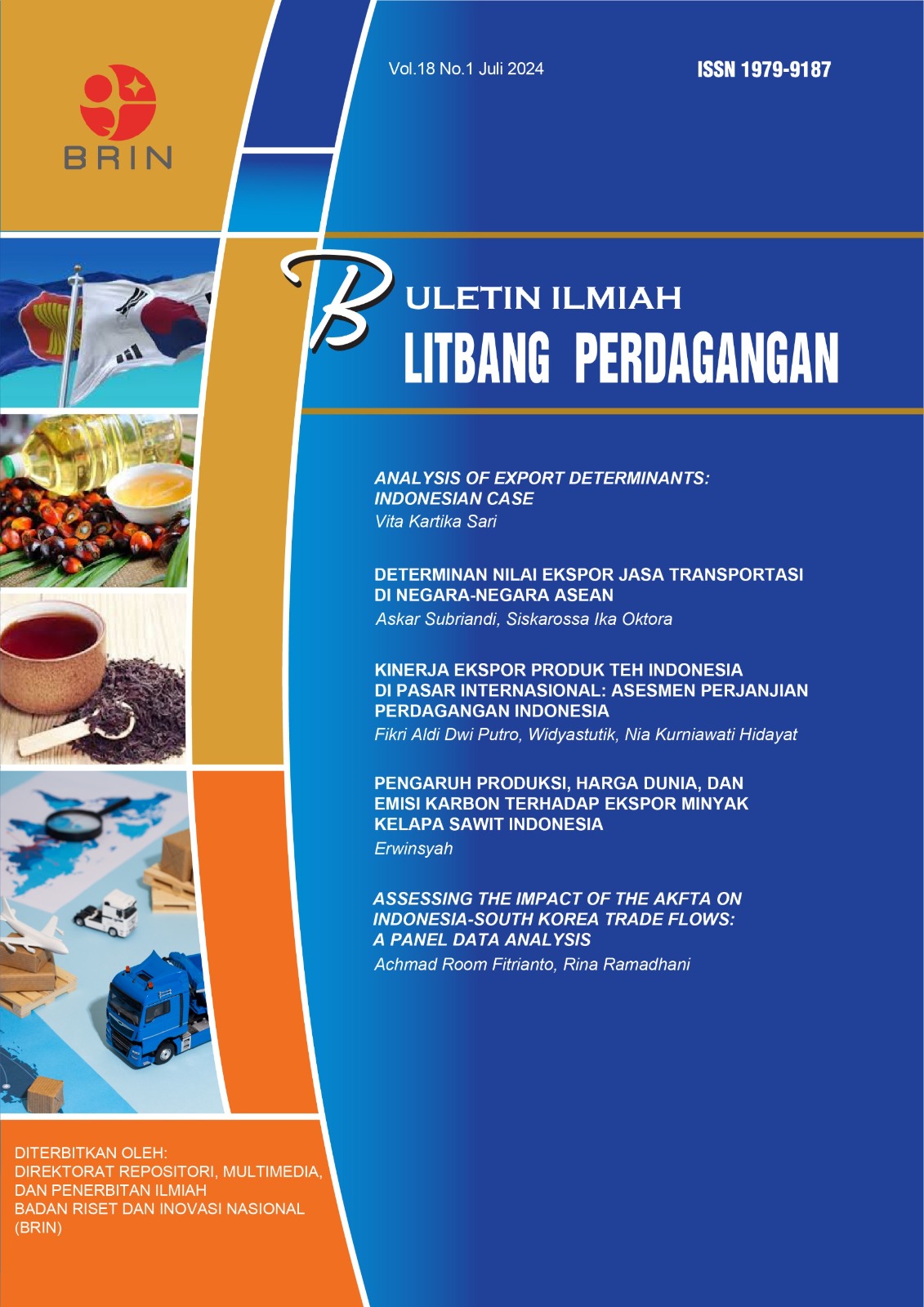Assessing the Impact of the AKFTA on Indonesia-South Korea Trade Flows: A Panel Data Analysis
DOI:
https://doi.org/10.55981/bilp.2024.1057Keywords:
AKFTA, Trade Agreements, Trade Creation, Trade DiversionAbstract
This study examines the impact of the ASEAN-Korea Free Trade Area (AKFTA) on trade flows between Indonesia and South Korea. This cooperation will impact trade diversion or even trade creation between Indonesia and countries in ASEAN-Korea. This study uses panel data regression analysis and secondary data sources on trade and other macroeconomics from various trusted institutions, such as United Nations, World Bank, etc., as well as the results of scientific research. The research results show that the implementation of AKFTA causes trade diversion on the export side and trade creation on the import side. The findings of this study also highlight that the implementation of AKFTA has an impact on the tendency to increase the value of Indonesian imports from both AKFTA members and non-members. However, the aggregate effect of AKFTA on trade creation is still more significant than trade diversion. Therefore, to overcome the trade diversion resulting from AKFTA, the government can make various efforts by negotiating with trading partner countries to obtain tariff reductions and open market access to new products.
Downloads
References
Anggaristiyadi, G. (2011). Analysis of the influence of per capita income, Rupiah exchange rate against the Dollar, foreign exchange reserves and inflation on Indonesia's import development in 1985-2008. [Thesis]. Surakarta: Universitas Sebelas Maret. https://digilib.uns.ac.id/dokumen/detail/18157/Analisis-Pengaruh-Pendapatan-Perkapita-Nilai-Tukar-Rupiah-terhadap-Dolar-Cadangan-Devisa-dan-Inflasi-terhadap-Perkembangan-Impor-Indonesia-Tahun-1985-2008.
ASEANStatistics. (2021). ASEAN statistical yearbook 2021. In ASEAN Statistics (Vol. 18). The ASEAN Secretariat. https://asean.org/wp-content/uploads/2021/12/ASYB_2021_All_Final.pdf
Darma, W.S., Hastiadi, F.F. (2017). Trade creation and trade diversion effects of the ASEAN-China free trade agreement, ASEAN-Korea free trade agreement, and ASEAN-India free trade agreement implementation on the export of Indonesia’s food and beverages industry products. International Journal of Economics and Financial Issues, 7(6), 51–58. https://doi.org/10.2991/icied-17.2018.18.
Dewi, S. khamila, Sahara, & Sri Mulatsih. (2020). The Impact of ACFTA (ASEAN-China Free Trade Area) on Indonesia's trade creation and trade diversion in the ACFTA+3 area. Journal of Economics and Development Policy, 8(1), 84–100. https://doi.org/10.29244/jekp.v8i1.29879.
Hajar Aswad, & Zulva Azijah. (2021). Influence of ACFTA (ASEAN-China Free Trade Area) on imports of phone origin China in ASEAN. Journal of Economics and Development Policy 10(2), 154–175. https://doi.org/10.29244/jekp.10.2.2021.154-175.
IMF. (2021). Indonesia and the IMF. https://www.imf.org/en/Countries/IDN.
Kemendagri. (2014). Law number 39 of 2008 concerning the State Ministry. https://peraturan.bpk.go.id/Details/39719/uu-no-39-tahun-2008.
Kurniasari, F., & Monica, L. (2019). The effect of exchange rates, interest rates and gross domestic product on export and import volumes in Indonesia. Journal of Business & Applied Management, 8(2). https://doi.org/http://dx.doi.org/10.30813/jbam.v12i01.1614.
Laird, S., & Yeats, A. (1990). Quantitative methods for tradebarrier analysis (1st ed.). Palgrave Macmillan UK. https://doi.org/https://doi.org/10.1007/978-1-349-11141-1.
Lipsey, R.G, & Lancaster, K. (1956-1957). The general theory of second best. The Review of Economic Studies, 24(1), 11-32. https://www.jstor.org/stable/2296233.
Mareta, B. M. T. (2018). The Impact of ASEAN-Korea free trade agreements on Indonesian export of manufacturing goods. Etikonomi, 17(2), 161–184. https://doi.org/10.15408/etk.v17i2.7342.
Nopirin. (1997). International economics (3rd ed.). BPFE Yogyakarta.
Nwali, C., & Arene, C. (2015). Effects of economic partnership agreements on agricultural trade between Nigeria. International Journal of Food and Agricultural Economics, 3(2, Special Issue), 63–74. https://doi.org/DOI: 10.22004/ag.econ.206307.
Ritaningsih, T. (2014). Trade creation and trade transfer between Indonesia and ASEAN-Korea countries. Journal of Economics and Development Policy, 3(2), 136–157. https://doi.org/10.29244/jekp.3.1.2014.64-81.
Salvatore, D. (1997). Ekonomi internasional. Erlangga.
Salvatore, D. (2014). Ekonomi internasional (9th ed.). Salemba Empat.
Viner, J. (1950). The economics of customs unions (The Custom). Carnegie Endowment for International Peace.
Zidi, A., & Dhifallah, S. (2013). Trade creation and trade diversion between Tunisia and EU: Analysis by Gravity Model. International Journal Economics and Finance, 5(5), 131–147. https://doi.org/doi:10.5539/ijef.v5n5p131.
Downloads
Published
How to Cite
Issue
Section
License
Copyright (c) 2024 Achmad Room Fitrianto, Rina Ramadhani

This work is licensed under a Creative Commons Attribution-ShareAlike 4.0 International License.




 Buletin Ilmiah Litbang Perdagangan
Buletin Ilmiah Litbang Perdagangan